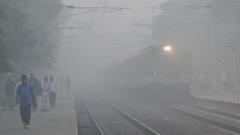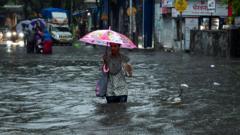Delhi finds itself again choking under heavy smog, as past solutions fail to materialize, leaving citizens caught in a relentless dystopian cycle.
Smog in Delhi: A Dystopian Cycle of Pollution and Despair

Smog in Delhi: A Dystopian Cycle of Pollution and Despair
As winter cloaks Delhi in a suffocating haze, despair and resignation wash over its residents.
Delhi's winter has brought a familiar gloom, with the city once again engulfed in dense smog that creates a despairing atmosphere akin to a dystopian film. As pollution disrupts transportation and schools shutter their doors, health warnings proliferate, advising vulnerable individuals to avoid outdoor exposure. This year, air quality indices soared dangerously high—measuring between 1,200 and 1,500, far exceeding the acceptable threshold of 100—triggering widespread outrage on social media platforms. As residents reminisce about previous grim winters, the specter of recurring issues looms large, reminiscent of past 15 years of relentless smog seasons.
Cars crawl through the murky streets as the city winds through the same script—pollution reports exploding in headlines, court mandates urging action, and politicians engaging in the blame game, yet little sustainable change appears forthcoming. Agricultural practices, particularly crop burning in nearby states, significantly contribute to this bleak scenario, compounded by vehicular and industrial emissions within Delhi itself. While many flee the city or invest in air purifiers, those unable to escape remain trapped, facing the dire health repercussions of breathing toxic air.
Notably, activism seems muted, as the health crisis endures unnoticed by the majority, often not translating into mass mobilization for change. Experts stress the critical need for collaboration across government levels while urging citizens to demand accountability and proactive solutions well before the pollution peaks. This winter, amidst temporary measures like banning construction, the question remains: will permanent change ever come to deliver Delhi from its persistent veil of smog? As history suggests, optimism appears in short supply.




















